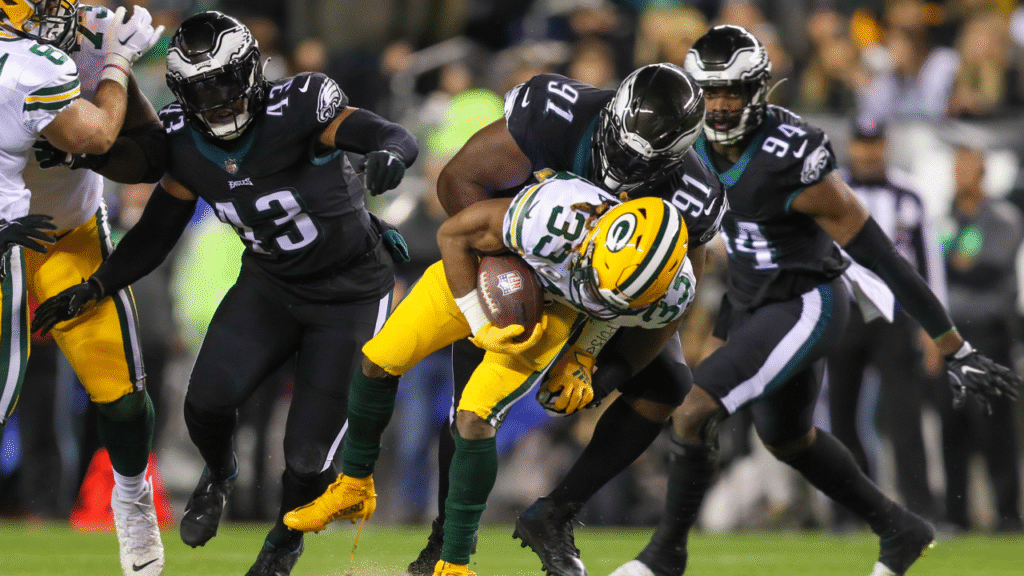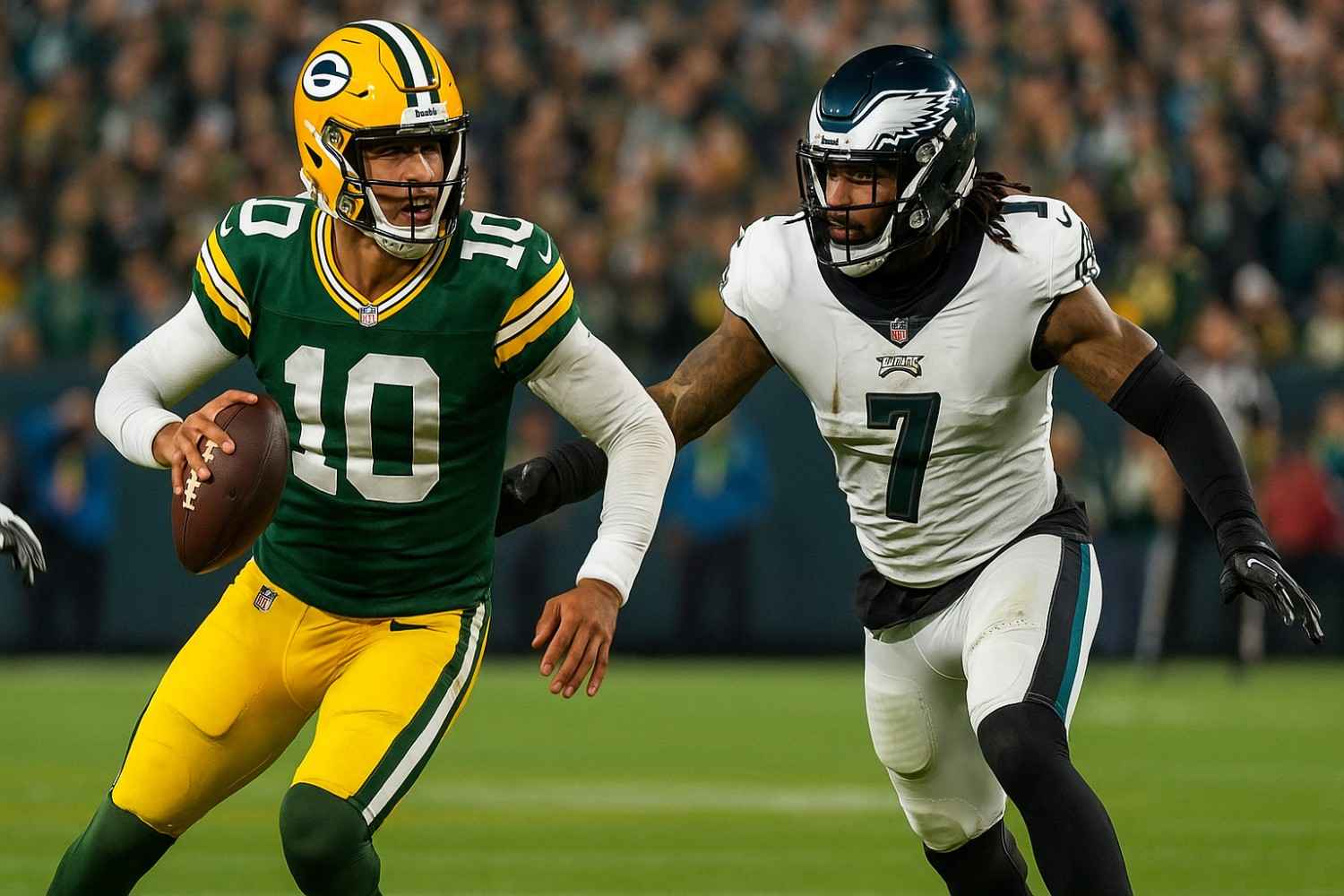The Green Bay Packers vs Philadelphia Eagles Match Player Stats Wild Card playoff game, held on January 12, 2025, ended with a 22–10 victory for the Eagles. It was a defensive battle marked by early turnovers, strong rushing performances, and missed chances by the Packers.
Philadelphia set the tone early with a forced fumble on the opening kickoff, immediately turning it into a touchdown. The Eagles built a 10–0 lead in the first quarter, with Jalen Hurts finding Jahan Dotson in the end zone after the early turnover. The Packers responded in the second half with a strong rushing drive led by Josh Jacobs, narrowing the gap to 16–10. But in the fourth quarter, Jordan Love threw his third interception, sealing the Packers’ fate.
The Eagles controlled the game with smarter decisions and a more balanced attack, especially from Saquon Barkley, who dominated on the ground. Despite having fewer total yards, the Eagles capitalized on Packers turnovers, maintaining control and composure when it mattered most.
Table of Contents
Team Stats at a Glance
Looking at the overall team statistics, the Eagles and Packers had fairly close numbers in terms of yardage, but the big difference was in turnovers and red zone efficiency. The Eagles didn’t produce huge offensive numbers, but their ability to protect the ball and score when it mattered was the real separator.
| Stat Category | Green Bay Packers | Philadelphia Eagles |
|---|---|---|
| Total Yards | 302 | 290 |
| Passing Yards | 212 | 185 |
| Rushing Yards | 90 | 105 |
| First Downs | 17 | 18 |
| Third Down Efficiency | 4/12 (33%) | 6/13 (46%) |
| Turnovers | 4 | 0 |
| Time of Possession | 29:27 | 30:33 |
| Penalties (Yards) | 6 (45) | 5 (40) |
While the Packers outgained the Eagles in total yardage, they failed to convert on several key third-down plays and turned the ball over four times. On the other side, the Eagles were efficient in scoring positions, converting red zone chances into touchdowns and field goals. Their slightly better time of possession and clean turnover sheet allowed them to keep control of the game’s pace.
Turnovers were the biggest difference. The Packers lost the ball on three interceptions and a fumble, while the Eagles played a mistake-free game. This simple stat line—+4 turnover differential for Philly—reflects exactly why they came out on top.

Quarterback Performance
Jordan Love (Packers)
Jordan Love had one of the most disappointing outings of his playoff career. He completed 20 of 33 passes for 212 yards but threw three interceptions, all of which stalled crucial drives. Love struggled particularly on throws of 10 yards or more, completing just 3 of 11 deep attempts. The Eagles defense clearly studied his habits, disguising coverages and forcing errors in the second half.
Despite showing promise in earlier games, Love seemed overwhelmed by the Eagles’ pressure. He was sacked twice, hurried multiple times, and often made risky throws into double coverage. The offensive line did not offer much help either, collapsing on key third downs, which forced Love into uncomfortable, off-balance throws.
Jalen Hurts (Eagles)
On the other side, Jalen Hurts wasn’t spectacular statistically, but he played a much cleaner and more controlled game. He threw for 185 yards, including two touchdowns, with zero interceptions. After returning from injury, there were questions about his sharpness, but he managed the offense efficiently and avoided big mistakes.
Hurts connected with Jahan Dotson for an 11-yard touchdown and later found Dallas Goedert on a 24-yard strike, which was arguably the play of the night. He also contributed on the ground with a few crucial scrambles, keeping the Packers’ defense honest. His decision-making, especially under pressure, showed maturity and poise that ultimately guided the Eagles to victory.
Rushing & Ground Game Analysis
The ground game played a central role for both teams, but Saquon Barkley was the clear standout. His 25 carries for 119 yards gave the Eagles a physical edge, especially in the second half when they needed to chew clock and control possession.
| Player | Carries | Rushing Yards | TDs |
|---|---|---|---|
| Saquon Barkley (PHI) | 25 | 119 | 0 |
| Josh Jacobs (GB) | 18 | 81 | 1 |
| Jalen Hurts (PHI) | 5 | 21 | 0 |
Josh Jacobs was solid for Green Bay. His 81 yards and one touchdown came mostly in the second and third quarters, when the Packers tried to establish some rhythm. But without balance or help from the passing game, Jacobs couldn’t carry the team on his own.
Meanwhile, Barkley’s runs consistently set up short-yardage third downs, kept the Eagles out of trouble, and wore down the Green Bay front line. His vision, acceleration through the gaps, and ability to break arm tackles kept drives alive at crucial moments.
Receiving Highlights & Touchdowns
The game didn’t feature high-flying receiving numbers, but there were a few highlight moments. Philadelphia’s Dallas Goedert and Jahan Dotson both found the end zone, while Jayden Reed led the Packers in receiving yards.
| Player | Receptions | Yards | Touchdowns |
|---|---|---|---|
| Dallas Goedert (PHI) | 4 | 60 | 1 |
| Jahan Dotson (PHI) | 3 | 38 | 1 |
| Jayden Reed (GB) | 6 | 78 | 0 |
| Romeo Doubs (GB) | 4 | 54 | 0 |
Dallas Goedert’s touchdown was a crowd-pleaser. After catching a mid-range pass near the 20-yard line, he broke a tackle and stiff-armed a defender into the end zone. Dotson’s touchdown was a perfect strike in the corner of the end zone, showcasing timing and precision between Hurts and the receiver.
For the Packers, Jayden Reed was the most reliable target, often finding holes in zone coverage. However, none of the Packers receivers found the end zone, reflecting their red zone struggles.
Turnovers and Defensive Standouts
Defense was the true storyline. The Eagles defense forced four turnovers: three interceptions and one fumble. These came at critical times—early in the game, mid-drive, and in the red zone.
| Defensive Highlight | Player | Result |
|---|---|---|
| Forced Fumble | Oren Burks (PHI) | Set up early TD |
| Red Zone Interception | Quinyon Mitchell | Killed Packers’ last hope |
| 11 Tackles & Fumble Forced | Reed Blankenship | Defensive anchor |
| Sack on 3rd Down | Nolan Smith (PHI) | Drive-stopper |
Oren Burks delivered a tone-setting hit on the opening kickoff, forcing a fumble that led to the Eagles’ first touchdown. Reed Blankenship was everywhere—posting 11 total tackles and forcing another fumble. Quinyon Mitchell’s interception in the red zone late in the game sealed the win.
The Packers’ defense had moments, but not enough support. Their secondary missed assignments, and the front seven struggled to contain Barkley. Pre-snap confusion and missed tackles hurt them repeatedly.
Short FAQs
Q1: Who scored touchdowns for the Eagles?
Jahan Dotson and Dallas Goedert both caught touchdown passes.
Q2: How many turnovers did the Packers have?
Four: three interceptions and one fumble.
Q3: Who had the most rushing yards?
Saquon Barkley led all players with 119 rushing yards.
Q4: Did Jordan Love throw any touchdowns?
No, he threw for 212 yards but had three interceptions.
Q5: What was the final score?
Philadelphia Eagles 22, Green Bay Packers 10.
Advanced Metrics & X‑Factors
This section dives deeper into the numbers that go beyond the traditional box score—metrics like completion percentage over expected (CPOE), pressure rate, and red zone conversion. These advanced stats show us why the Eagles won, even though the yardage totals were close.
For Jordan Love, the pressure stats were brutal. He faced pressure on 38% of his dropbacks and completed just 2 of 9 passes under pressure. His CPOE was -7.2%, meaning he underperformed based on the difficulty of the throws. This was caused largely by confusion under blitzes, where Love often hesitated or threw into coverage.
Meanwhile, Jalen Hurts, though conservative, had a +3.5% CPOE, showing he was hitting throws at or slightly above expected difficulty. He also scrambled out of pressure on key third downs and avoided turnovers entirely. His ability to read zone defense quickly and get the ball out in under 2.5 seconds helped him stay clean and avoid sacks.
Read More: Buffalo Bills vs Baltimore Ravens Match Player Stats
Offensive Line X-Factor
- Eagles’ offensive line gave up 0 sacks and just 2 QB hits, a testament to both the protection and Hurts’ quick decisions.
- Packers’ line gave up 2 sacks, 6 QB hits, and several breakdowns that led to hasty throws and stalled drives.
Red Zone Efficiency
| Team | Red Zone Trips | TDs | Conversion Rate |
|---|---|---|---|
| Eagles | 3 | 2 | 67% |
| Packers | 2 | 1 | 50% |
In playoff football, red zone efficiency is everything, and the Eagles capitalized more often. One missed red zone chance by Green Bay—ending in a field goal instead of a touchdown—kept them from gaining momentum in the third quarter.
Winners, Losers & Key Takeaways
Every game tells a story beyond stats. This one was about execution under pressure, ball security, and mental toughness. Let’s look at the biggest winners and losers from this matchup.
Winners
- Saquon Barkley (Eagles): His 119 rushing yards gave Philly control of the clock. He consistently moved the chains.
- Dallas Goedert (Eagles): Big plays and physical dominance helped shift momentum.
- Eagles Defense: Four forced turnovers, including a game-sealing interception, were game-defining.
Losers
- Jordan Love (Packers): The numbers don’t lie—three interceptions in a playoff game is a killer.
- Packers Offensive Line: Couldn’t handle stunts and blitzes, leading to broken plays.
- Green Bay Receivers: Failed to make contested catches or win matchups in the red zone.
Key Takeaways
- Turnovers decide games, especially in the playoffs.
- The Eagles didn’t need explosive plays—they just played smart and stayed mistake-free.
- The Packers, despite showing flashes, lacked consistency and failed in crucial moments.
As Packers head coach Matt LaFleur said post-game:
“We had our chances. But in the playoffs, if you give the ball away four times, you don’t win.”
What It Means Going Forward
For the Eagles, this game confirms they’re more than just a flashy offense—they can win ugly, grind out tough victories, and play disciplined football. With Saquon Barkley running well and the defense creating turnovers, they have a strong foundation to make a deep playoff run. Still, their passing game must improve against tougher competition.
For the Packers, the loss stings because the opportunity was there. They moved the ball decently but self-destructed with turnovers and poor protection. The offseason will now focus on solidifying the offensive line, reviewing Jordan Love’s progress, and perhaps adding a more dynamic playmaker to stretch the field.
This game also serves as a reminder: playoff football rewards the patient, punishes the reckless, and demands execution in big moments. The Eagles met that challenge. The Packers did not.

